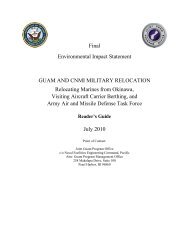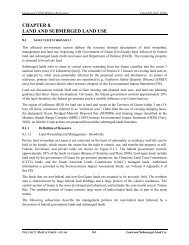- Page 1 and 2: 1. Table of Contents Appendix G EIS
- Page 3 and 4: Appendix G EIS Resource Technical A
- Page 7 and 8: Guam and CNMI Military Relocation F
- Page 9 and 10: Guam and CNMI Military Relocation F
- Page 13 and 14: Guam and CNMI Military Relocation F
- Page 15 and 16: Guam and CNMI Military Relocation F
- Page 17 and 18: Guam and CNMI Military Relocation F
- Page 19 and 20: Guam and CNMI Military Relocation F
- Page 21 and 22: Guam and CNMI Military Relocation F
- Page 23 and 24: Guam and CNMI Military Relocation F
- Page 25 and 26: Guam and CNMI Military Relocation F
- Page 27 and 28: Guam and CNMI Military Relocation F
- Page 29 and 30: Guam and CNMI Military Relocation F
- Page 31 and 32: Guam and CNMI Military Relocation F
- Page 33 and 34: Guam and CNMI Military Relocation F
- Page 35 and 36: Guam and CNMI Military Relocation F
- Page 37 and 38: Guam and CNMI Military Relocation F
- Page 39 and 40: Guam and CNMI Military Relocation F
- Page 43 and 44: Guam and CNMI Military Relocation F
- Page 45: Guam and CNMI Military Relocation F
- Page 49 and 50: Guam and CNMI Military Relocation F
- Page 51 and 52: Guam and CNMI Military Relocation F
- Page 53 and 54: Guam and CNMI Military Relocation F
- Page 55 and 56: Guam and CNMI Military Relocation F
- Page 57 and 58: Guam and CNMI Military Relocation F
- Page 59 and 60: Guam and CNMI Military Relocation F
- Page 61 and 62: Guam and CNMI Military Relocation F
- Page 63 and 64: Guam and CNMI Military Relocation F
- Page 65 and 66: Guam and CNMI Military Relocation F
- Page 67 and 68: Guam and CNMI Military Relocation F
- Page 69 and 70: Guam and CNMI Military Relocation F
- Page 71 and 72: Guam and CNMI Military Relocation F
- Page 73 and 74: Guam and CNMI Military Relocation F
- Page 75 and 76: Guam and CNMI Military Relocation F
- Page 77 and 78: Guam and CNMI Military Relocation F
- Page 79 and 80: Guam and CNMI Military Relocation F
- Page 81 and 82: Guam and CNMI Military Relocation F
- Page 83 and 84: Guam and CNMI Military Relocation F
- Page 85 and 86: Guam and CNMI Military Relocation F
- Page 87 and 88: Guam and CNMI Military Relocation F
- Page 89 and 90: Guam and CNMI Military Relocation F
- Page 93 and 94: Guam and CNMI Military Relocation F
- Page 95 and 96: Guam and CNMI Military Relocation F
- Page 97 and 98:
Guam and CNMI Military Relocation F
- Page 99 and 100:
Guam and CNMI Military Relocation F
- Page 101 and 102:
Guam and CNMI Military Relocation F
- Page 103 and 104:
Guam and CNMI Military Relocation F
- Page 105 and 106:
Guam and CNMI Military Relocation F
- Page 107 and 108:
Guam and CNMI Military Relocation F
- Page 109 and 110:
Guam and CNMI Military Relocation F
- Page 111 and 112:
Guam and CNMI Military Relocation F
- Page 113 and 114:
Guam and CNMI Military Relocation F
- Page 115 and 116:
Guam and CNMI Military Relocation F
- Page 117 and 118:
Guam and CNMI Military Relocation F
- Page 119 and 120:
Guam and CNMI Military Relocation F
- Page 121 and 122:
Guam and CNMI Military Relocation F
- Page 123 and 124:
Guam and CNMI Military Relocation F
- Page 125 and 126:
Guam and CNMI Military Relocation F
- Page 127 and 128:
Guam and CNMI Military Relocation F
- Page 129 and 130:
Guam and CNMI Military Relocation F
- Page 131 and 132:
Guam and CNMI Military Relocation F
- Page 133 and 134:
Guam and CNMI Military Relocation F
- Page 135 and 136:
Guam and CNMI Military Relocation F
- Page 137 and 138:
Guam and CNMI Military Relocation F
- Page 139 and 140:
Guam and CNMI Military Relocation F
- Page 141 and 142:
Guam and CNMI Military Relocation F
- Page 143 and 144:
Guam and CNMI Military Relocation F
- Page 145 and 146:
Guam and CNMI Military Relocation F
- Page 149 and 150:
Guam and CNMI Military Relocation F
- Page 151 and 152:
Guam and CNMI Military Relocation F
- Page 153 and 154:
Guam and CNMI Military Relocation F
- Page 155 and 156:
Guam and CNMI Military Relocation F
- Page 157 and 158:
Guam and CNMI Military Relocation F
- Page 159 and 160:
Guam and CNMI Military Relocation F
- Page 161 and 162:
Guam and CNMI Military Relocation F
- Page 163 and 164:
Guam and CNMI Military Relocation F
- Page 165 and 166:
Guam and CNMI Military Relocation F
- Page 167 and 168:
Guam and CNMI Military Relocation F
- Page 169 and 170:
Guam and CNMI Military Relocation F
- Page 171 and 172:
Guam and CNMI Military Relocation F
- Page 173 and 174:
Guam and CNMI Military Relocation F
- Page 175 and 176:
Guam and CNMI Military Relocation F
- Page 177 and 178:
Guam and CNMI Military Relocation F
- Page 179 and 180:
Guam and CNMI Military Relocation F
- Page 181 and 182:
Guam and CNMI Military Relocation F
- Page 183 and 184:
Guam and CNMI Military Relocation F
- Page 185 and 186:
Guam and CNMI Military Relocation F
- Page 187 and 188:
Guam and CNMI Military Relocation F
- Page 189 and 190:
Guam and CNMI Military Relocation F
- Page 191 and 192:
Guam and CNMI Military Relocation F
- Page 193 and 194:
Guam and CNMI Military Relocation F
- Page 195 and 196:
Guam and CNMI Military Relocation F
- Page 197 and 198:
Guam and CNMI Military Relocation F
- Page 199 and 200:
Guam and CNMI Military Relocation F
- Page 201 and 202:
Guam and CNMI Military Relocation F
- Page 203 and 204:
Guam and CNMI Military Relocation S
- Page 205 and 206:
Guam and CNMI Military Relocation U
- Page 209 and 210:
Guam and CNMI Military Relocation F
- Page 211 and 212:
GRN Storm Water Implementation Plan
- Page 213 and 214:
GRN Storm Water Implementation Plan
- Page 215 and 216:
GRN Storm Water Implementation Plan
- Page 217 and 218:
GRN Storm Water Implementation Plan
- Page 219 and 220:
GRN Storm Water Implementation Plan
- Page 221 and 222:
GRN Storm Water Implementation Plan
- Page 223 and 224:
GRN Storm Water Implementation Plan
- Page 225 and 226:
GRN Storm Water Implementation Plan
- Page 227 and 228:
GRN Storm Water Implementation Plan
- Page 229 and 230:
GRN Storm Water Implementation Plan
- Page 231 and 232:
GRN Storm Water Implementation Plan
- Page 233 and 234:
GRN Storm Water Implementation Plan
- Page 235 and 236:
GRN Storm Water Implementation Plan
- Page 237 and 238:
GRN Storm Water Implementation Plan
- Page 239 and 240:
GRN Storm Water Implementation Plan
- Page 241 and 242:
GRN Storm Water Implementation Plan
- Page 243 and 244:
GRN Storm Water Implementation Plan
- Page 245 and 246:
GRN Storm Water Implementation Plan
- Page 247 and 248:
GRN Storm Water Implementation Plan
- Page 249 and 250:
GRN Storm Water Implementation Plan
- Page 251 and 252:
GRN Storm Water Implementation Plan
- Page 253 and 254:
GRN Storm Water Implementation Plan
- Page 255 and 256:
GRN Storm Water Implementation Plan
- Page 257 and 258:
GRN Storm Water Implementation Plan
- Page 259 and 260:
GRN Storm Water Implementation Plan
- Page 261 and 262:
GRN Storm Water Implementation Plan
- Page 263 and 264:
GRN Storm Water Implementation Plan
- Page 265 and 266:
GRN Storm Water Implementation Plan
- Page 267 and 268:
GRN Storm Water Implementation Plan
- Page 269 and 270:
GRN Storm Water Implementation Plan
- Page 271 and 272:
GRN Storm Water Implementation Plan
- Page 315 and 316:
GRN Storm Water Implementation Plan
- Page 317 and 318:
GRN Storm Water Implementation Plan
- Page 319 and 320:
GRN Storm Water Implementation Plan
- Page 321 and 322:
GRN Storm Water Implementation Plan
- Page 323 and 324:
GRN Storm Water Implementation Plan
- Page 325 and 326:
GRN Storm Water Implementation Plan
- Page 327 and 328:
GRN Storm Water Implementation Plan
- Page 329 and 330:
GRN Storm Water Implementation Plan
- Page 331 and 332:
GRN Storm Water Implementation Plan
- Page 333 and 334:
GRN Storm Water Implementation Plan
- Page 337 and 338:
Guam and CNMI Military Relocation F
- Page 339 and 340:
Printing Date: May 21, 2010, M:\pro
- Page 341 and 342:
Printing Date: May 10, 2010, M:\pro
- Page 343 and 344:
Printing Date: May 19, 2010, M:\pro
- Page 345 and 346:
Printing Date: May 19, 2010, M:\pro
- Page 347 and 348:
Printing Date: May 10, 2010, M:\pro
- Page 349 and 350:
Printing Date: May 10, 2010, M:\pro
- Page 351 and 352:
Printing Date: May 19, 2010, M:\pro
- Page 353 and 354:
Printing Date: May 10, 2010, M:\pro
- Page 435 and 436:
Guam and CNMI Military Relocation F
- Page 437 and 438:
Guam and CNMI Military Relocation F
- Page 439 and 440:
Guam and CNMI Military Relocation F
- Page 441 and 442:
Guam and CNMI Military Relocation F
- Page 443 and 444:
Guam and CNMI Military Relocation F






